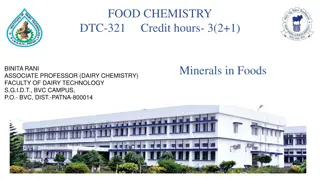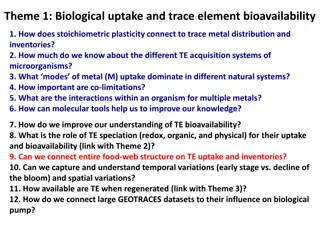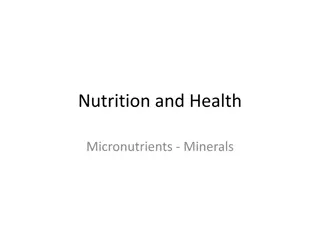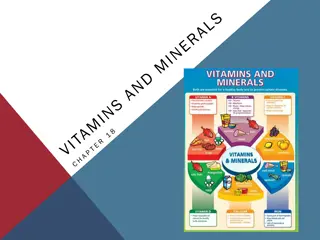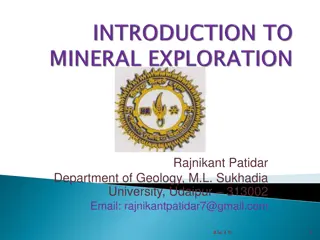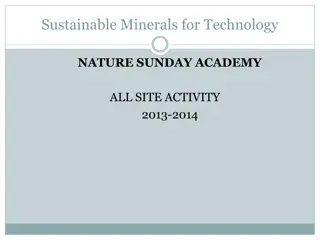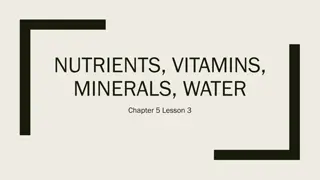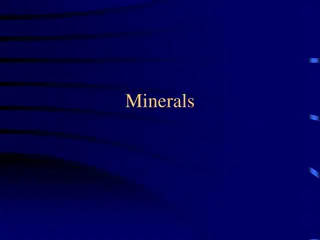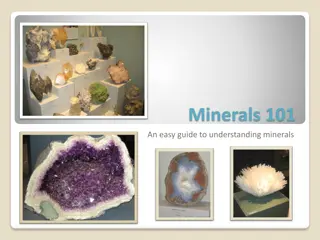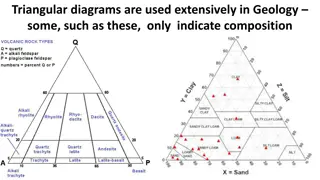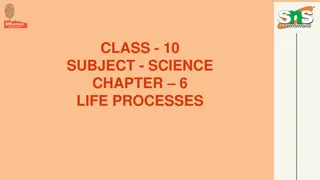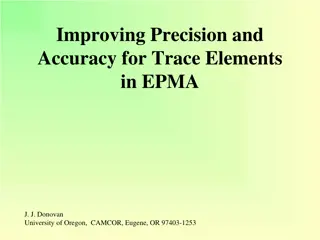Overview of Minerals and Trace Elements in Human Nutrition
Minerals and trace elements play essential roles in the human body, categorized into groups based on their functions and requirements. Nutritional minerals like calcium, phosphorus, and magnesium are needed in larger amounts, while trace elements such as zinc and iron are required in smaller quantities. Absorption, regulation, and sources of minerals are crucial for maintaining balance, while disorders from excess or deficiency can lead to health issues. Understanding the importance of minerals is key to ensuring optimal health and well-being.
Download Presentation

Please find below an Image/Link to download the presentation.
The content on the website is provided AS IS for your information and personal use only. It may not be sold, licensed, or shared on other websites without obtaining consent from the author. Download presentation by click this link. If you encounter any issues during the download, it is possible that the publisher has removed the file from their server.
E N D
Presentation Transcript
MINERALS AND TRACE ELEMENTS BY PROFESSOR DR. JAMAL AHMED ABDEL- BARRY
Minerals The elements can be considered in 5 groups 1. Includes C, H, O, N, and S: It is the major components of body molecule these elements are obtained through the intake of water, foods, fats, CHO, and proteins. 2. Nutritional minerals: Ca, P, Mg, Na. K and Cl, that are required in the diet in amounts 100 mg /day. 3. Trace elements: Cr, Co, Cu, Zn, I, Fe, Mn, F, Mo, Se, are required in the diet in much smaller amounts. 4. Additional elements: Which having no known essential function as As, Cd, Ni, Si, tin and Vanadium. 5. Toxic elements: As lead and mercury.
Absorption of minerals Most elements form salts (soluble) as Na+, K+. and others are relatively in soluble, they are not readily absorbed and most are excreted in feces. Minerals absorption, as well as its transport and storage required specific carrier protein . The synthesis of these proteins serves mechanism for control minerals levels.
Disorder due to mineral excess or deficiency Body mineral concentration regulated at level of absorption or Excretion, whoever circulating levels do not necessarily reflect the intake, it is represent the equilibrium between the amounts absorbed, utilization, storage and the excretion, and test on serum or urine mineral are not always accurate to give an indication of intake. Mineral deficiency are not due to dietary intake since, a variety of foods include most of mineral, however, deficiency occurs secondary to. 1. Malabsorption. 2. Excess bleeding (Fe). 3. Renal disease (Ca). 4. Other clinical problems.
Source of minerals Minerals are found in most foods, grains, fruits and vegetables, dry foods, meets and fish.
Sodium Important and Functions: Is the major cat ion of ECF because it represents 90% of plasma. Responsible of half , of the osmolality of the plasma. Play a central role in maintaining normal distribution of water and osmotic pressure of ECF. Absorption Normal diet contain 8 to 15 gm of NaCl. Which regulate the amounts of Na in the body. 1. Na initially filtered by glom rule. 2. 60---70 % of filtered absorbed in the proximal tubules with HCO3,and water. 3. 25---30% reabsorbed in the loop of Henley along with CL.
4. Aldosterone hormone affected and directly modulate reabsorption of Na and indirectly Cl from the remaining 5 10% of the filtered in the distal tubules which having Na K and Na H exchange system. Hyponatremia 1.Decrease intake of Na (particularly participated). 2. Un usual losses of Na from GIT, kidneys, sweat glands. a. Depletion hyponatremia due to 1. Prolong vomiting. 2. Persistent diarrhea. 3. Salt losing enteropathies (Na loss more than water).
b. Renal loss due to 1.Diminished tubular reabsorption which may by use diuretics drugs. 2. Primary or secondary deficiency of aldosterone or glucocorticoids. 3. In poly urea. This condition is common in 1. Metabolic acidosis ( diabetic ketoacidosis). 2. Renal tubular acidosis, due to impaired absorption or defect in Na H exchange. 3. Any condition make urine alkaline in alkalosis which increase renal loss of Na.
Hypernatremia 1. Excessive loss of Na poor fluid ,water loss in vomiting or in diarrhea and polyuria. 2. Decreased production of ant diuretic hormone, or decrease tubular sensitivity to the action of this hormone. 3. High intake of saline, or salt with low intake of water. 4. In hyperaldosteronism. (Cushing Syndrome).
Potassium Potassium is the predominant intracellular cat ion . 90% of K is free while 10% is bound in the RBC, bone and tissue, 2% of total K is located in the ECF. Homeostasis Extra cellular K controlled by 1. Kidney. 2. By GIT. In the kidney The filtered K is almost completely reabsorbed in the proximal tubules and some active secretion takes place in the distal part , but excretion of K is passive.
The active re absorption of Na generate a membrane potential which is neutralized by movement of K and H ions. Thus urinary K excretion depends on 1. Amount of Na available for re absorption in the distal convoluted tubules and collecting duct. 2. Amount of H and K in the distal convoluted tubules. 3. The ability of these cells to secrete H ions. 4. The concentration of aldosterone. 5. The rate of tubular fluid. Aldosterone Stimulate K execration both indirectly by increasing the active re absorption of Na in the distal and collecting ducts and directly by increasing the active K secretion in the distal part.
There is close relation ship between K and H ions in homeostasis. In acidosis: H tend to be secreted in preference to K and hyperkalemia was occur. In alkalosis: Few H is available for excretion and Hypokalemia is occur. An exception for this in renal tubular acidosis: Defect in H ion excretion and increase K excretion to balance Na re - absorption and the results is un usual condition of Hypokalemia. The health kidney is less efficient to conserving K as Na and anther route for loss K is from the skin and gut. Explain why K depletion produce alkalosis?
K is secreted in gastric juice and much of this re absorbed in the small intestine. In the colon and rectum, K is secreted in exchange for Na and under control of aldosterone. Stool contain some K but considerable amount may lost in patients with fistulae and chronic diarrhea or in patients losing gastric secretion the persistent vomiting. Net loss of K from the cell 1. If the Na pump is inefficient as in diabetic ketoacidosis and in hypoxic state. 2. In acidosis, when K is displaced from the cells. Net gain of K by the cell 1. Activity of Na pump increase as after administration of glucose and insulin this object to treat hyperkalemia. 2. In alkalosis: Induction alkalosis used to treat hyperkalemia.
Hypokalemia Due to loss of K from the body: a. loss from ECF in intestinal secretion 1. Prolong vomiting. 2. Diarrhea. 3. intestinal fistula. b. loss from ECF in urine 1. Increase activity of Na K exchange in distal tubule. 2. In Cushing syndrome, due to effect mineralocorticoid on distal tubules. 3. Increase Na concentration for exchange. 4. Decrease renal Na H exchange, favoring Na K exchange. 5. Reduce proximal tubular K re absorption. Renal tabular failure.
c. Reduce K+ intake. d. Redistribution in the body. Glucose, and insulin therapy. Hyperkalemia 1.Increase gain of K+ by the body. a. Increase up take of ECF from intestine , or in IV routes. 2. Failure for renal secretion. a- Decrease activity of Na--K exchange. b- Hypoaldosterinosim in Addison's disease. c- Sodium depletion, little sodium for exchange. 3. Increase sever tissue damage increase release from ICF. a. diabetic ketoacidosis due to failure to Na pump. Resulting from impaired glucose metabolism due to lack of insulin.
Definition of Trace elements Trace element Are those element occur in human and animal tissue in milligram per kilogram amount and requirement also reported in milligram per day. Ultra trace element Refer to those element present in tissue in microgram per kilogram amount with estimated daily requirement in microgram per day. Essential Trace Element That element required for life and its absence results in death or a sever malfunction of organism.
Copper Is an essential trace element it is required in the diet because it is the metal cofactor for a variety of enzymes. Cu accepts and donate electrons and is involve in the reaction involving dismutation, hydxylation, and oxygenation, however excess Cu can cause problem because it can oxidize protein and lipid and can bind to nucleic acid and enhance the production of free radicals.
It is thus important to have mechanisms that will maintain the amount of Cu in the body within normal limits. The body of the normal adult contains about 100mg of Cu located mostly in the bone ,liver, kidney and muscle. The daily intake of Cu is about 2-4 mg with about 50% being absorbed in the stomach and upper small intestine and the remainder excreted in the feces. Cu is carried to the liver bound to albumin taken up by liver cell and part of it is excreted in the bile Cu also leaves the liver attached ceruloplasmin which is synthesized in that organ.
Cereuloplasmin Cereuloplasmin: Is copper binding protein. low levels of this plasma protein are associated with Wilson disease. Cereuloplasmin about (150 Kda) is an alpha 2 globins'. It has blue color because of its high Cu content and carries 90% of the Cu present in the plasma. Each molecule of cereuloplasmin bind six atom of Cu tightly so that the Cu is not readily exchangeable.
Albumin carries the other 10%of the plasma Cu but bind the metal less tightly than dose ceruloplasmin. Albumin thus donates its Cu to tissue more readily than cereuloplasmin and appears to be more important than cereuloplasmin in Cu transport in the human body. Ceruloplasmin exhibits a Cu dependent oxidase activity but its physiologic significance has not been clarified apart from possible involvement in the oxidation of Fe+2 to Fe+3 to be taken by transferrin.
Some important enzymes that contain Cu:(amine oxidase, Cu dependent superoxide dismutase ,cytochromes oxidase, tyrosinase ). The tissue levels of Cu and of certain other metal are regulated in part by Metallothioneins. Metallothioneins: Are a group of small protein about 6.5kda found in the cytosol of cell particularly of liver, kidney, and intestine . They have a high content of cysteine and can bind Cu, Zinc, Cadmium and Mg.
Menkes disease Menkes disease (kinky or steely hair disease is a disorder of Cu metabolisms. Is due to mutations in the gene encoding a (copper-binding p- type ATPase). It is X-link, affects only male infant involve the C.N.S, connective tissue and vasculature and usually fatal in infancy. This ATPase is thought to be responsible for directing the efflux of copper from cells.
When altered by mutation, copper is not mobilized normally from the intestine, in which it accumulates, as it does in a variety of other cells and tissues, from which it cannot exit. Despite the accumulation of copper, the activities of many copper- dependent enzymes are decreased, perhaps because of a defect of its incorporation into the Apo enzymes. Normal liver expresses very little of the ATPase, which explains the absence of hepatic involvement in Menkes disease. This work led to the suggestion that liver might contain a different copper-binding ATPase, which could be involved in the causation of Wilson disease, as described below.
Wilson disease o Is also due to mutation in gene encoding a copper-binding p-type ATPase. o Wilson disease is genetic disease in which Cu fails to be excreted in the bile and accumulated in liver, brain, kidney and blood cells. It can be regarded as an inability to maintain a near zero copper balance resulting in copper toxicosis. The increase of Cu in liver cells appears to inhibit the coupling of Cu to Apoceruloplasmin and lead to low level of cereuloplasmin in plasma. o
A frequent clinical finding is the Kayser-Fleischer ring this is the a green or golden pigment ring around the cornea due to deposition of Cu in descrements membrane.
The major laboratory tests of Cu metabolism are listed in this table
If Wilson disease is suspected a liver biopsy should be performed . A value for liver Cu of over 250 g per gram dry weight along with a plasma level of cereuloplsmin of under 20 mg /dl is diagnostic.
ZINC Zinc is found in biological system only in the +2 valence state so that biological oxidation reduction function is not possible with zinc. The metabolic function of zinc are based on its 1- Presence as integral component of many metalloenzyme the most important include: Carbonic anhydrase, alkaline phosphatase, DNA and RNA polymerase, Thymidine kinase, Carboxy peptidase and alcohol dehydrogenase.
2. The zinc atom are an integral firmly bound and are often involved in the active site. 3.They also contribute the conformation and structural stability of many metallo enzyme. 4. Zinc play major role in protein synthesis and has important function in gene expression . 5. Zn has been shown to be an important element in wound healing by affecting the biosynthesis and integrity of connective tissue.
Metabolism: Zinc is second to iron as the most abundant trace element in the body it about (1.4 2.3 g) present in 70 kg adult. ( prostate, liver, semen, kidney, bone and muscle) are rich in zinc. The zinc content of erythrocyte is about 10 time that of plasma, best of their rich content of carbonic anhydrase and other zinc containing enzyme. proximally 20 30 % of ingested dietary zinc absorbed if available.
The availability of dietary zinc is decrease by high amount of Ca, Phosphate, iron and Cu. The compound that have positive effect on zinc absorption include EDTA, lysine, glycine and histidine. Diet rich in protein stimulate zinc absorption whereas diet low in protein has the opposite effect. The RDA for zinc is( 15 mg/day) for adult male, zinc is transport in plasma mostly by: a. Albumin 60 70 %. b. Alpha 2 microgloibin 30 -40 %. c. Small amount with transferrin and amino acid.
Clinical significance In mild zinc deficiency Oligospermia, weight loss and hyperammonemia. In moderate zinc deficiency Growth retardation in children and adolescent, hypogonadism in males, mild dermatitis , poor appetite and delayed wound healing. In severe case of zinc deficiency Dermatitis, weight loss , diarrhea , neuropsychiatric disorders , recurrent infection, and ultimately death if not treated . Beside nutritional factor many disease and medical treatment may produce conditional zinc deficiency for example in hepatic cirrhosis, GIT disorders and in patient with Crohn disease, burn, renal disease.
Other cause of iatrogenic zinc deficiency: Include administration of anabolic steroid and chelating drug pencillamine. In patient receive long term treatment with synthetic oral diet and total parental nutritional are often trace element deficiency (zinc and others). Pregnant women at high risk of acquired zinc deficiency because of high uptake of zinc by the fetus. Zinc deficiency is also often associated with sickle cell anemia, zinc supplement may help to decrease risk of crisis.
Manganese It is present in biological system bound to protein either +2 or +3 valence state. Mn: Is associated mainly with the formation of connective and bony tissue with growth and reproductive function and with carbohydrate and lipid metabolism. Its function as constituent of metalloenzyme and as an enzyme activates. The important Mn containing enzymes include( Arginase, pyruvate carboxylase and Mn superoxide dismutase in mitochondria).
Metabolism Total amount of Mn in adult human = 12 20 mg. Bone , liver and pancreas tend to have higher concentration of Mn than other tissue. The estimated adequate and safe intake is 2 5 mg /day in adult Clinical significant Mn is accepted as essential for human mainly on the bases of its proven role in the( Mn dependent enzyme), and on the product if Mn deficiency in animal rather than on direct evidence of human deficiency. Blood clotting defect, hypercholesterolemia, dermatitis and elevated serum calcium, phosphate and alkaline phosphates have been reported in some subject experimentally depleted of Mn, however Mn supplementation was not shown to completely correct these symptoms.
Molybdenum:(Mo) It is essential for incorporation into 3 metallo enzyme( xanthine oxidase, aldehyde oxidase, sulfite oxidase ). Metabolism 25 80 % of ingested Mo is absorbed, the highest amount of Mo are retained in the liver after absorption most Mo is rapidly turned over and eliminated via the urine. However, significant amount also excreted in the bile. Estimated safe and adequate dietary intake 75 250 ug/dl. Mo is relatively non toxic to human, high dietary and occupational expose to Mo have been linked to elevated uric acid in the blood increase incidence of gout.
Clinical significance Well defined cases of dietary human Mo deficiency have been reported. A possible congenital defect in Mo metabolism was suggested for an infant who showed feeding difficultly, mental retardation and biochemical defect in xanthine sulfite oxidase activity.
Chromium Cr Its function in the control of glucose and lipid metabolism. Cr is potentiate of insulin action, glucosetolerance factor, GTF, has been suggested to be organic low molecular weight complex that contain trivalent Cr. Nicotinic acid , glutamic acid , glycine and sulfur containing amino acid (cysteine). GTF is the Cr related substance that potentiate the action of insulin.
Clinical significance Clinical significant of Cr rest primarily with its relation to glucose metabolism. In USA simple addition of 150 mg of Cr to the daily diet improve glucose tolerance in maturity onset diabetes Type II.
Selenium It is constituent of enzyme glutathione peroxidase, isolated from human erythrocyte and type 2 thyroxine 5 deiodinase. Biochemistry Most Se in tissue present in two form Selano cysteine and Selano methionine. Selano methionine is unregulated storage compartment for selenium. Selano -cysteine is biologically active form of Se and is tightly regulated. Selenium help the organism against oxidative stress. Its involve in the metabolism of thyroid hormone .
Glutathione peroxidase catalyse the breakdown of H2O2, phospholipid hydroperoxidase and other free hydroperoxidase. Metabolism More than 50 % was absorbed from intestinal tract, RDA for men and women 70 and 55 mg/day respectively, dietary intake vary dependably of the selenium status of the geographical area. The principle dietary form are seleno -amino acid.
Seleno methionine is derived from plant , seleno- cysteine from animal source. Se homeostasis is achieved by regulation of its excretion via the urine in addition vary high intake of Se lead to exhalation of volatile form of Se. Clinical significance Keshan disease An endemic cardiomyopathy that affect primarily children and women of child bearing age in certain area of china has been associated with Se deficiency the patient have low glutathione peroxidase activity , hair and serum Se concentration that are 30 40 % lower than control level.
Kashin Beck disease: An endemic osteoarthritis that occur during adolescent. Is another disease linked to low selenium status in china. Epidemiological studies have related impaired Se status and intake with increase incidence of cancer and cardiomyopathy.
Cobalt Cobalt is essential For Humans Only as an integral part Of vitamin B12 (cobalamin). No other function for cobalt in the Human body is known. Micro flora of the human Intestine Are Not Able To Use Cobalt To Synthesize Physiologically Active cobalamin. The human vitamin B12 Requirement Must be supplied by the diet. Free (non-vitamin B12) cobalt does Not Interact with the body vitamin B12 pool
Floride It has unique pharmacological propriety in preventing tooth decay although floride has been shown to effect enzyme activity and growth in animal , its benefit for human nutrition lies in its anti carcinogenic action. Biochemistry Inorganic florid is readily absorbed in small intestine and distribute entirely to bone and teeth. Renal excretion is the most important for regulation of body florid content.
Normal serum or plasma concentration 10 200 ug/l in adult the estimated safe and adequate intake = 1.5 4 mg/day. Floriated drinking water contribute appreciable to total fluoride intake. Sea food and Tea are higher in fluoride than cereal , grains and cow milk.


